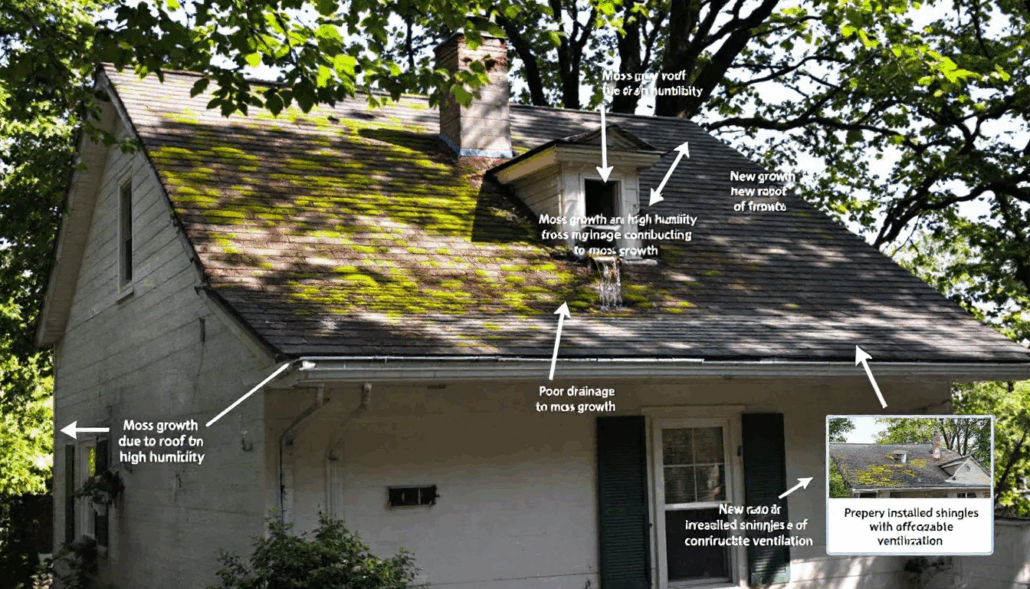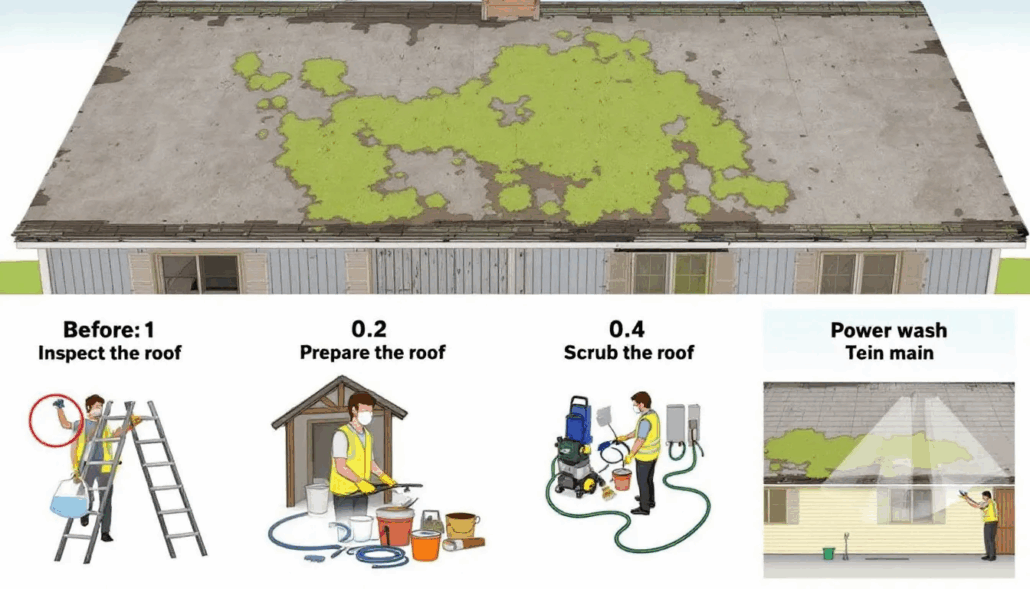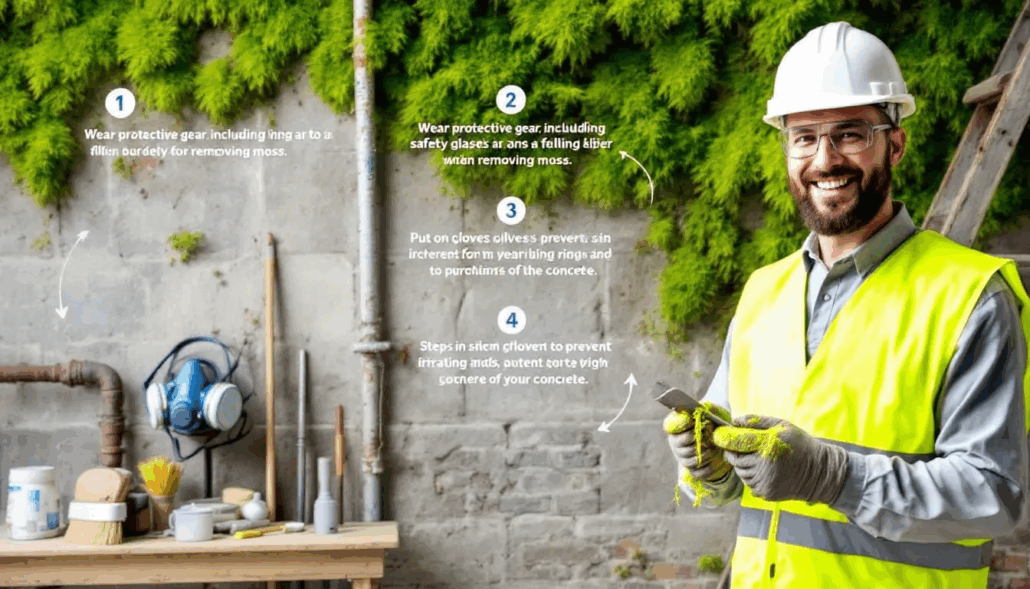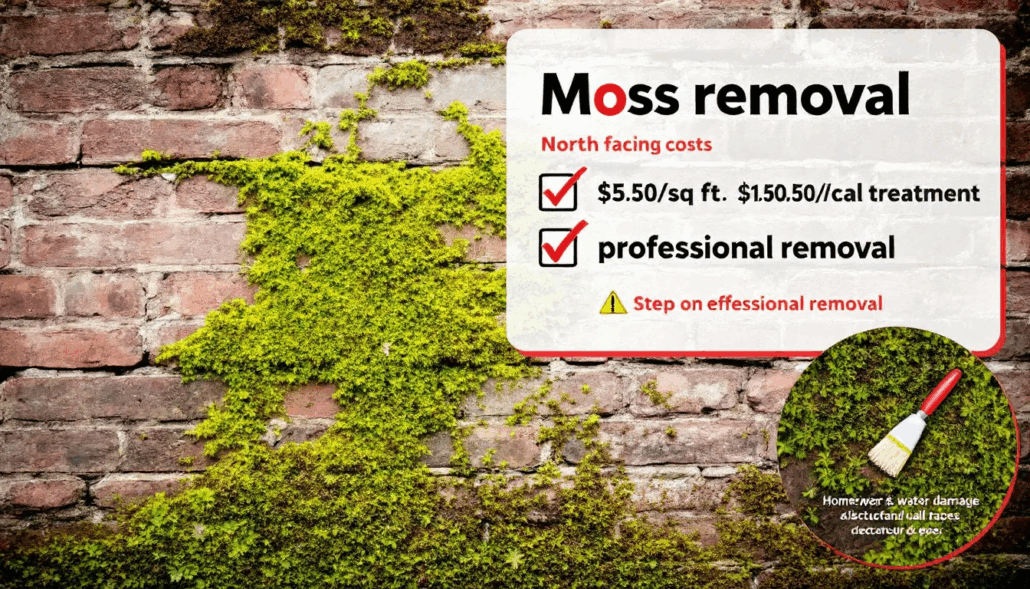Top Tips on How to Get Moss Off Roof in Iowa
If you’re battling moss on your home’s roof in Iowa, you’re not alone. Regular inspections are crucial to assess the roof’s condition and identify any issues early. The damp climate here makes moss a common issue that can damage your roof. Moss can compromise the roof’s integrity, leading to material decay and safety hazards for maintenance access. Maintaining your home’s roof is crucial to prevent moss growth and avoid larger issues. Hiring a professional roofing contractor for regular roof maintenance ensures thorough inspections and effective moss removal. This guide will show you exactly how to get moss off of a roof in Iowa, covering both manual and chemical removal methods, the best times to treat, and preventive steps.
Key Takeaways
- Moss thrives in damp, shaded conditions, making it essential for homeowners in Iowa to monitor their roofs regularly, especially during wet months.
- The best time for manual removal of moss is summer, while chemical treatments are most effective in fall or spring during the moss’s active growing season.
- Preventive maintenance like cleaning gutters, trimming branches, and regular inspections can significantly reduce the chances of moss growth on roofs and help keep the roof in good shape.
- Hire a professional for extensive moss growth or safety concerns to ensure thorough and safe removal.
- Ensure proper ventilation in attics to prevent moss growth and maintain a healthy roofing system.
- While a home inspector can identify potential issues with the roof during a real estate transaction, a dedicated roofing professional is recommended for a more thorough assessment.
Understanding Moss Growth in Iowa

Moss thrives in moist environments, often proliferating in areas that experience significant rainfall and are shaded. In Iowa’s damp and shadowed locales, moss commonly infests roofs. The presence of moss can trap moisture against the roof’s surface, heightening the risk of water damage and threatening the structural integrity of the roof, especially where there is standing water. Additionally, moss can lead to mold growth, which negatively impacts living conditions.
The lifecycle of moss is sensitive to seasonal shifts. Thus it requires close observation during months with higher precipitation levels. From autumn through spring marks a period when moss actively grows and matures. During these seasons, if not swiftly managed, moss has the potential to expand quickly on rooftops. It’s essential for homeowners to engage in consistent maintenance to deter well-established growths from causing any architectural harm. Regular inspections are crucial to assess the roof’s condition and identify any issues early. Moss can compromise the roof’s structural integrity, leading to costly repairs. Trapped moisture from moss can also cause significant water damage.
Asphalt shingles are vulnerable to degradation from moisture-laden moss which can instigate wood rot along with various other forms of structural deterioration. Grasping how moss propagates as well as its detrimental effects empowers homeowners with knowledge enabling them effectively mitigate or prevent grave damages afflicting their roofs.
Best Time for Moss Removal in Iowa
The timing of moss removal from roofs is crucial for effective results. The summer season offers the best conditions for manual removal, as moss adheres less firmly to shingles, simplifying the physical elimination process.
For chemical treatments aimed at eradicating moss down to its roots, the application should coincide with the plant’s peak growth periods in either fall or spring. Administering these chemicals when temperatures are cooler and rain isn’t expected will maximize their impact. Utilizing a product designed to kill moss can be particularly potent during these seasons. It is also essential to follow the manufacturer’s instructions when using chemical treatments to ensure safety and effectiveness.
Adhering to appropriate timings for removing moss ensures that both manual and chemical methods are optimally efficient while preserving roofing materials from damage. By strategically planning maintenance activities according to seasonal patterns of growth and weather conditions, homeowners can maintain clear roofs throughout all months of the year. Proper scheduling facilitates not only ease but also durability in keeping rooftops devoid of unwanted green guests like moss.
Effective Methods for Removing Moss from Roofs

Numerous strategies exist for eliminating moss from roofs, and each comes with its unique benefits and factors to bear in mind. Mechanical methods require the physical extraction of moss using implements such as brushes or roof rakes. In contrast, chemical approaches involve deploying compounds that target the root system of the moss, ensuring it is comprehensively removed. Using a moss killer can be an effective chemical method to eliminate moss and prevent its regrowth.
When performing manual moss removal, it is crucial to use a sturdy ladder to safely reach the roof and prevent any potential damage to the roofing materials.
Selecting an appropriate method hinges on both the current state of your roofing and how comfortable you are with undertaking the process. While hands-on techniques can yield good results, they require considerable effort. Conversely, chemical means provide a less laborious alternative but necessitate precise application to prevent harm to your roofing materials. Hiring professional roofers can ensure that moss removal is done safely and effectively, as they have the expertise and tools necessary for the job. Additionally, pressure washing can be used to remove moss from roof tiles, but it must be done with caution to avoid damaging the roof tiles or shingles.
Let us explore these options more thoroughly.
Manual Moss Removal Techniques
The process of removing moss manually from a roof entails the use of either a broom or another similar implement to brush away the growth. This technique is most effective when applied during summer, as this is when moss enters its dormant state and does not cling as tenaciously to roof shingles. By employing a rigid broom or specialized tool known as a roof rake, individuals can carefully strip away unwanted plant matter without harming their roofing material.
However, improper manual removal techniques can risk causing damage to the roof. Executing manual removal provides immediate relief from unsightly moss accumulations but requires careful handling so that one doesn’t inadvertently damage the shingle surfaces beneath. A preventative measure includes routinely eliminating both debris and any branches looming over roofs since these tend to cast shadows that facilitate an environment conducive for the continued proliferation of moss.
Despite being an effective strategy, extracting moss by hand might prove too strenuous and time-consuming for some homeowners who must then deliberate on whether it’s worth expending personal effort versus possibly engaging professional services—especially in instances where there is substantial coverage of persistent green invaders demanding attention.
Chemical Treatments for Moss
Employing chemical solutions is a commonly preferred technique for eliminating moss on roofs. Adhering strictly to the manufacturer’s instructions is critical when utilizing chemical treatments in order to use them safely and effectively. The optimal time to apply these substances is during the summer months when cooler, drier conditions help maximize their potency. Solutions crafted specifically for roof application are among the top choices in combating roof moss, as they directly attack the problem to ensure thorough outcomes.
For those inclined towards eco-conscious options, there are natural alternatives that safeguard both roofing materials and environmental well-being. Homebrewed concoctions, which might include ingredients like white vinegar, warm water, and dishwashing liquid, can prove to be potent against moss as well. These chemical treatments aim at destroying the root system of the moss to guarantee its complete eradication while also deterring future growth.
Diligent preparation before applying chemicals contributes significantly toward attaining a free-roof from unsightly green clumps whilst preserving your roof’s structural soundness.
Preventive Measures to Keep Your Roof Moss-Free

Ensuring a moss-free roof hinges on consistent upkeep and taking preventive steps. It’s crucial to clear away accumulated debris such as leaves and twigs routinely to stave off the establishment of moss. Maintaining clean gutters is vital for proper water flow, thereby diminishing the damp conditions necessary for moss proliferation.
Pruning back branches that cast shade over your roof can increase sunlight exposure, which in turn helps inhibit the growth of moss. Enhancing ventilation within your attic space stands as an additional deterrent by reducing moisture levels and fostering an environment less hospitable to moss. Proper ventilation in the attic is essential to prevent moss growth and maintain a healthy roofing system. Additionally, ensuring that roofing components like roof flashing and drip edges are properly installed is crucial to prevent leaks and moss growth.
Adopting these preventive measures is instrumental for homeowners in preserving a free-roof from moss while also protecting its structural integrity. Diligent inspections and regular maintenance are fundamental in identifying potential issues promptly, facilitating timely intervention before they escalate into extensive repair needs. A roof inspector plays a crucial role in assessing the roof’s condition, ensuring proper insulation and ventilation, and maintaining the overall structural soundness of the roof.
Safety Tips Professionals Use for Moss Removal

Ensuring safety is of utmost importance for roofing professionals when they’re tasked with removing moss from roofs. They implement several precautionary measures to prevent any mishaps while conducting the removal process. The use of a stable ladder, secured by a spotter, greatly increases the level of safety involved in eliminating moss from roofs. Wearing non-slip shoes and protective attire such as safety goggles is crucial for safeguarding against falls and flying debris.
Performing moss removal under dry weather conditions is recommended to reduce the risk of slipping on rooftops that are slick with moisture-laden growths like moss. Moss can create slippery conditions, posing a significant safety hazard. Roofing professionals remain cautious when utilizing their tools and adhere strictly to established safety protocols during the task to avoid harm or injury.
For homeowners dealing with hard-to-reach areas or copious amounts of moss, it’s often most prudent to engage a roofing professional who specializes in such tasks, particularly if dealing with steeply pitched roofs where risks are amplified. Hiring an expert ensures not only that personal well-being is prioritized, but also guarantees thoroughness and efficiency due to their specialized equipment and proven expertise in safely managing roof-related jobs effectively.
Hiring professional roofers is essential for tasks that involve significant safety risks, as they possess the training in safety procedures and proper tools necessary to perform safe repairs and maintenance, ensuring the roof’s integrity is maintained.
When to Call in Professional Roofing Contractors
At times, the wisest decision is to enlist professional assistance. When removing moss from steep roofs, safety issues may arise that suggest the necessity for expert intervention. If moss has accumulated extensively and seems challenging to remove without specialized equipment, this indicates a need for skilled support due to potential safety risks. Hiring a professional roofing contractor ensures thorough roof inspections and maintenance, addressing any underlying issues effectively, including assessing and maintaining the roof’s structural integrity and determining if a new roof is needed.
By engaging a seasoned roofing contractor with expertise in handling such matters, you ensure that not only is the process conducted correctly, but also minimizes the chances of inflicting additional damage on your roof. Such professionals are well-versed in dealing with various types of roofing materials and understand how they interact with moss as well as employing suitable methods for its removal. Afterward, these experts can apply preventative treatments to maintain clean roofs over time. Regular roof inspections are crucial to identify and address potential issues early, preventing costly repairs or replacements in the future.
When it comes to hiring trusted contractors for this purpose, homeowners ought to consider those who have valid licenses and insurance along with positive reviews and referrals backing them up. Opting for professional help when tackling moss elimination promotes both efficacy in resolving the issue effectively while prioritizing personal safety throughout the procedure.
Cost Implications of Moss Removal
 The expense incurred for eliminating moss can fluctuate widely due to a variety of determinants. Noteworthy considerations include:
The expense incurred for eliminating moss can fluctuate widely due to a variety of determinants. Noteworthy considerations include:
- Typically, the cost for professional roof cleaning hovers around $400.
- Homeowners usually incur expenses ranging from $250 to $650 when they opt for such services.
- When manual labor is employed in moss removal, it tends to be the most expensive method, with an average cost of approximately $1,200 for an average-sized roof.
Roof inspection cost typically ranges from $120 to $400 depending on various factors such as the type of inspection and whether additional repairs are needed. Some roofing companies may offer free roof inspections as part of a service quote for repairs or replacements.
Several factors like the specific type of roof you have, local market competition among service providers and differing environmental conditions all contribute meaningfully towards determining the final price tag on moss elimination services. While tackling this task via DIY approaches might save money initially, these require considerable personal investment regarding time and physical effort.
Acknowledging that unchecked moss growth is not just an eyesore but could precipitate substantial repairs stemming from water infiltration damage makes investing in expertly provided moss eradication seem worthwhile. Adopting consistent upkeep alongside preventive strategies may prove beneficial by mitigating future costs over time. Investing in professional moss removal can save money in the long run by preventing costly repairs.
Benefits of Regular Roof Inspections
Having your roof inspected on a regular basis is essential for identifying and resolving minor issues before they escalate into significant problems. Early discovery of concerns like leaks or lost shingles can avert the need for extensive roof repairs, ultimately saving homeowners substantial sums by prolonging the life of their roofing materials. Regular roofing inspections are crucial in assessing the condition and integrity of your roof, ensuring that minor issues are addressed promptly. Hiring certified home inspectors for these inspections ensures a higher quality of service and thoroughness.
Fulfillment of warranty prerequisites often requires routine professional inspections of your roof. Consistently maintaining your home’s rooftop not only enhances its visual appeal, but also contributes to an increase in property value. Conducting these inspections routinely helps ensure safety by uncovering concealed structural problems that could otherwise result in dangers, including possible flaws with various roofing components and overall integrity, particularly concerning metal roofs. A thorough roof inspection is crucial in identifying potential issues and ensuring the roof’s structural integrity.
When it comes to home inspection processes, engaging professionals equipped with specialized expertise and tools ensures more comprehensive results. Investing modestly in regular inspections is advantageous as it maintains the condition of your roof while safeguarding your abode. This encompasses thorough scrutiny during both general home examinations and specific free roofing evaluations carried out by certified inspectors specializing in roofs as well as broader aspects related to house inspection.
Summary
Preserving a roof free of moss in Iowa involves understanding how moss proliferates, the timely eradication of this growth, and taking steps to prevent its return. Following the advice and employing tactics mentioned in this manual enables property owners to shield their roofs from harm attributable to moss, thereby prolonging the durability of their roofing materials.
Regular roof maintenance is essential for preventing larger issues, such as water damage and structural problems. Choosing a trustworthy roofing company for inspections and repairs ensures that your roof remains in optimal condition and prolongs its longevity.
Conducting routine inspections of your roof and seeking professional assistance when needed are crucial for detecting small problems before they escalate into expensive repairs. Commitment to regular maintenance and effectively removing moss will maintain your roof’s optimal state, thus ensuring long-term protection for your home.
Frequently Asked Questions
What is the best time for moss removal in Iowa?
For the best results in Iowa, tackle manual moss removal in summer, and if you’re using chemical treatments, aim for fall or spring.
It is crucial to follow the manufacturer’s instructions when using chemical roof moss killers to prevent potential harm to users, roofing materials, and the environment.
How does moss damage my roof?
Moss can seriously damage your roof by trapping moisture against it, which may lead to water damage and compromise its structural integrity. Additionally, moss can lead to mold growth, which negatively impacts living conditions.
It’s best to keep an eye on moss growth to avoid costly repairs! Moss can compromise the roof’s integrity, leading to material decay and safety hazards for maintenance access.
Can I remove moss from my roof myself?
Absolutely, you can remove moss from your roof yourself with a stiff broom or roof rake, but if there’s a lot of moss or if you’re worried about safety, hiring professionals is a smart choice.
When performing manual moss removal, it is crucial to use a sturdy ladder to safely reach the roof and prevent any potential accidents.
How much does professional moss removal cost?
Expect to pay between $250 and $650 for professional moss removal, depending on the size and condition of your roof.
Roof inspection cost typically ranges from $120 to $400 depending on various factors such as the type of inspection and whether additional repairs are needed.
It’s worth it to keep your roof in top shape!
What preventive measures can I take to keep my roof moss-free?
To keep your roof moss-free, regularly maintain it by cleaning gutters, trimming overhanging branches, and ensuring good attic ventilation. Proper ventilation in the attic is crucial to prevent moss growth and maintain a healthy roofing system.
These simple steps go a long way in preventing moss growth. A roofing inspector can assess the roof’s condition, identify potential issues, and ensure proper maintenance, including checking for proper insulation and ventilation in attic spaces.






